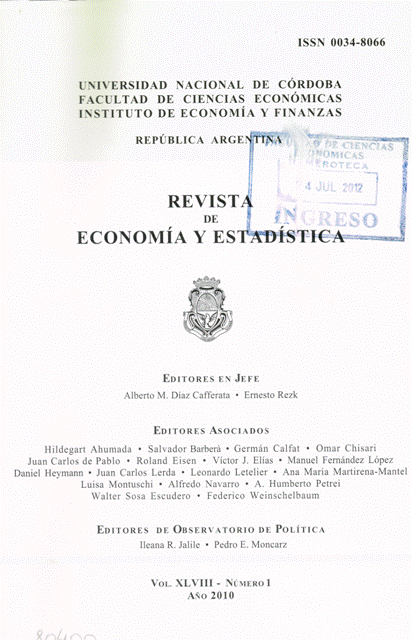Fiscal Policy in the United States: Automatic Stabilizers, Discretionary Fiscal Policy Actions, and the Economy
DOI:
https://doi.org/10.55444/2451.7321.2010.v48.n1.3870Keywords:
automatic stabilizers, discretionary actions, government budgetAbstract
We examine the effects of the economy on the government budget as well as the effects of the budget on the economy. First, we provide measures of the effects of automatic stabilizers on budget outcomes at the federal and state and local levels. For the federal government, the defi cit increases about 0.35 percent of GDP for each 1 percentage point deviation of actual GDP relative to potential GDP. For state and local governments, the defi cit increases by about 0.1 percent of GDP. We then examine the response of the economy to the automatic stabilizers using the FRB/US model by comparing the response to aggregate demand shocks under two scenarios: with the automatic stabilizers in place and without the automatic stabilizers. Second, we provide measures of discretionary fi scal policy actions at the federal and state and local levels. We fi nd that federal policy actions are somewhat counter-cyclical while state and local policy actions have been somewhat pro-cyclical. Finally, we evaluate the impact of the budget, from both automatic stabilizers and discretionary actions, on economic activity in 2008 and 2009.
Downloads
References
Autor and Duggan (2006). “The Rise in Disability Rolls and the Decline in Unemployment,” Journal of Economic Perspectives, Summer 71-96.
Auerbach, Alan J. (2003). “Fiscal Policy, Past and Present,” Brookings Papers on Economic Activity, 1, pp. 75-122.
Aizeman, Joshua and Gurnain Kaur Pasricha (2010). “On the Ease of Overstating the Fiscal Stimulus in the US, 2008-9,” NBER working paper 15784.
Blank, Rebecca (2001). “What Causes Public Assistance Caseloads to Grow?” Journal of Human Resources 36 No. 1 (Winter): 85-118.
Bryaton, F. and P. Tinsley (eds.) (1996). “A Guide to FRB/US: A Macroeconomic Model of the United States” Finance and Economics Discussion Series 1996-42. Washington: Board of Governors of the Federal Reserve System.
Cohen, Darrel (1987). “Models and Measures of Fiscal Policy.” Working Paper Series, Economic Activity Section, No. 70. Washington D.C.: Board of Governors of the Federal Reserve System.
Cohen, Darrel and Jason Cummins (2006). “A Retrospective Evaluation of the Effects of Temporary Partial Expensing,” Finance and Economics Discussion Series, 2006-19.
Cohen, Darrel and Glenn Follette (2000). “The Automatic Fiscal Stabilizers: Quietly Doing Their Thing.” Economic Policy Review 6 No. 1 (April): 35-68.
Coronado, Julia, Joseph Lupton and Louise Sheiner (2005). “The Household Spendng Response to the 2003 Tax Cut: Evidence from Survey Data,” Finance and Economics Discussion Series, 2005-32.
Council of Economic Advisers (2010). “The Economic Impact of the American Recovery and Reinvestment Act of 2009 Second Quarterly Report,” January 13.
deLeeuw, Frank, Thomas Holloway, Darwin Johnson, David McClain, and Charles Waite (1980). “The High-Employment Budget: New Estimates, 1955-1980.” Survey of Current Business (November): 13-43.
Follette, Glenn, Andrea Kusko and Byron Lutz (2008). “State and Local Finances and the Macroeconomy: The High-employment Budget and Fiscal Impetus,” National Tax Journal, September.
House, Christopher, and Matthew Shapiro (2008). “Temporary Investment Tax Incentives: Theory with Evidence from Bonus Depreciation,” American Economic Review, September, 1028-1038.
Johnson, David, Jonathan Parker and Nicholas Souleles (2004). “Household Expenditure and the Income Tax Rebates of 2001,” NBER working paper 10784.
Kalman, Rupp, and David Stapleton (1995). “Determinant of the Growth in the Social Security Administration’s Disability Programs—An Overview,” Social Security Bulletin, Winter.
Knight, Brian (2002). “Endogenous Federal Grants and Crowd-out of State Government Spending: Theory and Evidence from the Federal Highway Aid Program,'' American Economic Review, 92(1).
Knight, Brian, Andrea Kusko and Laura Rubin (2003). “Problems and Prospects for State and Local Governments.” State Tax Notes (August 11): 427-439.
Sahm, Claudia R., Mathew D. Shapiro, and Joel Slemrod (2009). "Household Response to the 2008 Tax Rebates: Survey Evidence and Aggregate Implications," Prepared for the NBER Conference on Tax Policy and the Economy Washington, DC (September).
Lutz, Byron (2008). “The Connection Between House Price Appreciation and Property Tax Revenues.” National Tax Journal (September).
Lutz (2010). "Taxation with Representation: Intergovernmental Grants in A Plebiscite Democracy", Review of Economics and Statistics, forthcoming.
National Association of State Budget Officers (2009). The Fiscal Survey of the States. Washington, D.C. (June).
National Conference of State Legislatures (2008). State Budget Actions FY 2007 and FY 2008. Denver CO. April.
U.S. Congressional Budget Office (2010). “Estimated Impact of the American Recovery and Reinvestment Act on Employment and Economic Output From October 2009 Through December 2009,” February.
U.S. Congressional Budget Office (various years). The Budget and Economic Outlook. Washington D.C.
van den Noord, Paul (2000). “The Size and Role of Automatic Fiscal Stabilizers in the 1990s and Beyond”, OECD Economics Department Working Papers, No. 230.
Downloads
Published
How to Cite
Issue
Section
License
Copyright (c) 2010 Glenn Follette, Byron Lutz

This work is licensed under a Creative Commons Attribution-NonCommercial-NoDerivatives 4.0 International License.
Authors who have publications with this journal agree to the following terms:
Authors retain their copyright and grant the journal the right of first publication of their work, which is simultaneously subject to the Creative Commons Attribution-NonCommercial-NoDerivatives 4.0 International License that allows third parties to share the work provided that its author and first publication in this journal are indicated.
Authors may adopt other non-exclusive licensing arrangements for distribution of the published version of the work (e.g. depositing it in an institutional telematic archive or publishing it in a monographic volume) as long as the initial publication in this journal is indicated.
Authors are allowed and encouraged to disseminate their work via the Internet (e.g. in institutional telematic archives or on their website) before and during the submission process, which can lead to interesting exchanges and increase citations of the published work. (See The Open Access Effect)









